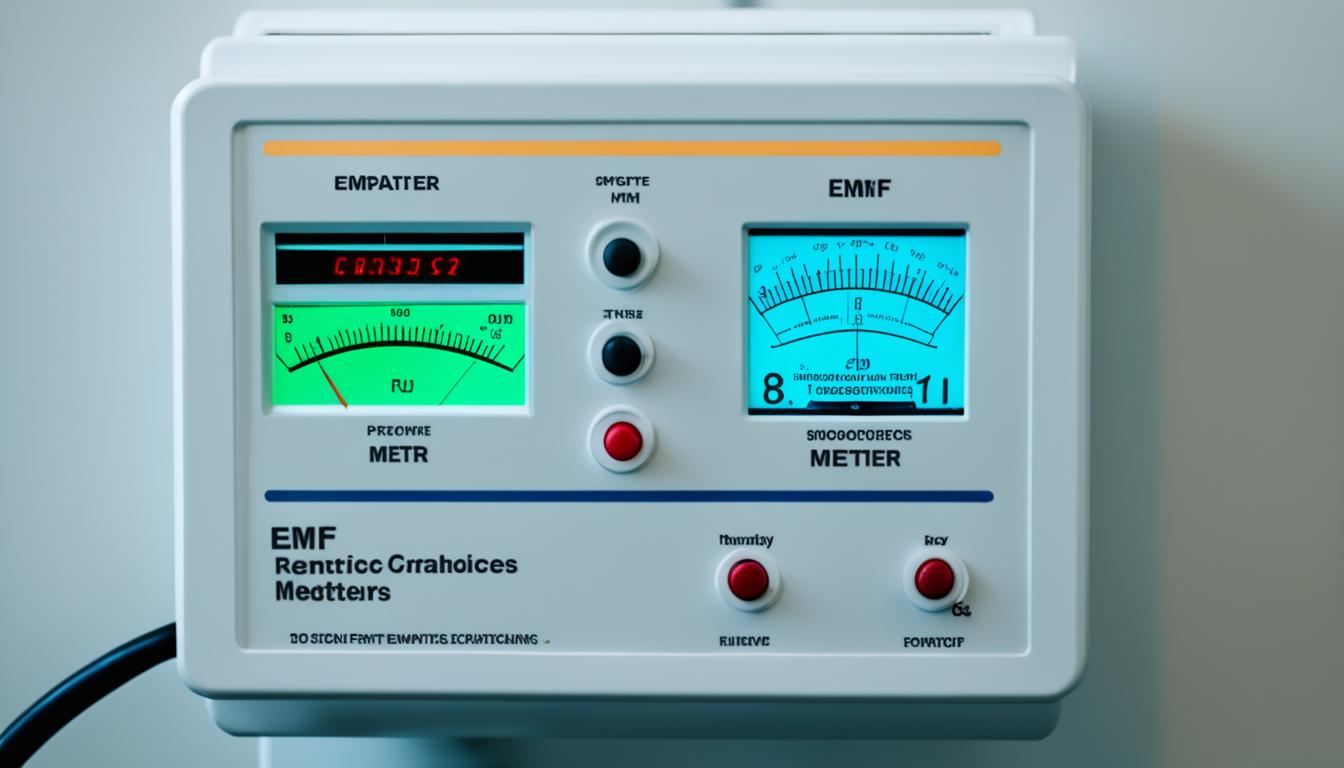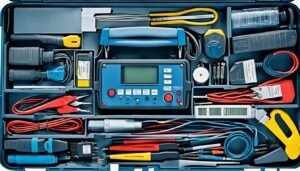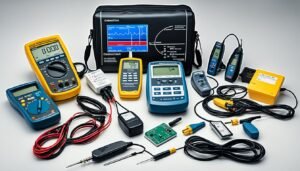Disclosure: This Post Contains Affiliate Links; We earn a commission on purchases.
Electromagnetic fields (EMFs) are a common presence in our everyday lives, generated by the use of electricity in our homes and businesses. While EMFs are invisible, they can potentially have an impact on our health. Therefore, it is important to understand and detect EMFs in the home to protect ourselves and our loved ones.
EMF meters are powerful tools that enable us to measure and detect electromagnetic fields. By using EMF meters, we can identify the sources of EMF exposure in our living spaces and take necessary precautions to minimize potential health risks. Whether it’s the appliances we use or the power lines outside our homes, EMF meters allow us to gain insights into the levels of EMFs and make informed decisions regarding our health and well-being.
Key Takeaways:
- EMFs are generated by the use of electricity and can be measured using EMF meters.
- Understanding and detecting EMFs in the home is essential for safeguarding against potential health risks.
- EMF meters help identify sources of EMF exposure, such as appliances and power lines, allowing for informed decision-making.
- Taking necessary precautions based on EMF detection results can reduce EMF exposure and promote a healthier living environment.
- Regular monitoring and awareness of EMF levels contribute to overall EMF safety in the home.
What is EMF and How is it Generated?
Electric and magnetic fields (EMFs) are fundamental forces of the universe that have existed since the beginning of time. Early civilizations even utilized the earth’s natural magnetic field for navigational purposes. However, with the introduction of electricity, human exposure to EMFs has increased significantly.
EMFs are a combination of electrical and magnetic fields that are generated whenever electricity is produced, transmitted, or used. These fields are present wherever there is electricity, whether it’s in our homes, workplaces, or other environments.
The strength of an EMF is directly related to the amount of electricity flowing through a circuit (current) and the voltage used. Electric fields, measured in volts per meter (V/m), are created by the presence of voltage, while magnetic fields, measured in teslas (T), are generated by flowing currents. The frequency of the electrical source can vary, ranging from zero for direct current to millions of cycles per second for alternating current.
Understanding the generation of EMFs is crucial to comprehending how these fields can affect our daily lives. By developing awareness of the sources and characteristics of EMFs, we can make informed decisions about minimizing our exposure and protecting our well-being.
EMF Generation Factors
To understand the generation of EMFs, it’s important to consider the following factors:
- Electricity: EMFs are a direct result of the utilization of electricity, whether it’s from power plants, electrical systems, or electronic devices.
- Magnetic Fields: Whenever there is a flow of electric current, a magnetic field is produced, in accordance with the laws of electromagnetism.
- Voltage and Current: The strength of an EMF is influenced by the amount of electrical voltage and current present in an electric circuit. Higher voltages and currents lead to more powerful EMFs.
- Frequency: The frequency of the electrical source, measured in hertz (Hz), determines the number of cycles per second. Different devices and systems operate at varying frequencies.
By considering these factors, we can better understand the nature of EMFs and their potential impact on our health and well-being.
“EMFs are a combination of electrical and magnetic fields that are generated whenever electricity is produced, transmitted, or used.”
| EMF Generation Factors | Description |
|---|---|
| Electricity | EMFs result from the use of electricity in various applications and devices. |
| Magnetic Fields | A flow of electric current creates a magnetic field according to the laws of electromagnetism. |
| Voltage and Current | The strength of an EMF is influenced by the amount of electrical voltage and current in a circuit. |
| Frequency | The frequency of the electrical source determines the number of cycles per second. |
Possible Health Effects of EMF Exposure
Exposure to external electromagnetic fields (EMFs) has raised concerns about potential health effects. The human body relies on internal electric fields and currents for various physiological mechanisms, making it crucial to understand the impact of external EMF exposure.
Research projects conducted by reputable organizations like the World Health Organization (WHO), Environmental Protection Agency (EPA), and Department of Energy (DOE) aim to enhance our knowledge and comprehension of EMF effects. By studying these effects, we can gain insights into the potential health risks associated with EMF exposure.
While current evidence does not support the notion that commonly encountered levels of EMF exposure have health effects, ongoing research and monitoring are essential for a comprehensive understanding of the topic.

“The World Health Organization encourages continued research on the possible health effects of electromagnetic fields and recognizes the importance of monitoring exposure levels.”
EMF Measurement and Detection Methods
When it comes to measuring and detecting electromagnetic fields (EMFs), there are various methods and tools available. One popular choice is to use EMF meters, which are designed specifically for this purpose. These meters come in different types, including broadband meters and frequency selective meters.
Broadband meters are capable of measuring a wide range of frequencies, making them versatile for general EMF measurement purposes. They provide an overall assessment of the EMF levels in a given environment, which can be useful in identifying potential sources of exposure.
Frequency selective meters, on the other hand, focus on specific frequency ranges. This allows for more targeted measurements, especially in situations where specific frequencies are of interest. These meters are commonly used in specialized applications where the frequency of the EMF source is known or suspected.
Another important consideration in EMF measurement is the type of probe used. Probes can be either isotropic (tri-axial) or mono-axial.
Isotropic probes are capable of simultaneously measuring the field components in three directions. This means they can provide a comprehensive evaluation of the EMF in terms of its intensity and directionality. These probes are particularly useful in situations requiring a thorough and accurate assessment of the EMF.
Mono-axial probes measure only one dimension of the field at a time. While they may not provide as comprehensive of a measurement as isotropic probes, they are still valuable in certain applications where a specific dimension of the EMF needs to be evaluated.
Ultimately, the choice of measurement method and tools depends on the specific requirements of the situation. Whether you opt for a broadband or frequency selective meter, or use an isotropic or mono-axial probe, conducting EMF measurements is an important step in understanding and managing potential EMF exposure.
Sample Table – Comparison of EMF Measurement and Detection Methods
| Measurement and Detection Methods | Advantages | Disadvantages |
|---|---|---|
| Broadband Meters | – Measure a wide range of frequencies – Provide an overall assessment of EMF levels – Versatile for general EMF measurement | – May lack specificity for targeted frequency analysis – May not provide detailed directional information |
| Frequency Selective Meters | – Focus on specific frequency ranges of interest – Suitable for specialized applications – Provide more targeted measurements | – Limited to specific frequency ranges – May require knowledge of the frequency of the EMF source |
| Isotropic Probes | – Simultaneously measure field components in three directions – Provide comprehensive evaluation of EMF intensity and directionality | – May be bulkier and heavier than mono-axial probes – Can be more expensive |
| Mono-axial Probes | – Measure specific dimensions of the EMF – Can be more cost-effective – Suitable for certain applications | – May require multiple measurements to assess all field components – Do not provide comprehensive directional information |

Practical Tips for Reducing EMF Exposure at Home
Reducing EMF exposure in your home is essential for maintaining a safe and healthy environment. By taking practical steps and implementing simple changes, you can minimize the impact of EMF sources and protect yourself and your family. Here are some practical tips to help you reduce EMF exposure:
1. Identify and Minimize EMF Sources
Start by identifying the major sources of EMFs in your home. These sources can include power lines, appliances, electronics, and wireless devices. Once you have identified these sources, take measures to minimize their impact. For example, rearrange your furniture to create distance between yourself and these EMF sources.
2. Keep a Safe Distance
Whenever possible, maintain a safe distance from EMF sources. The strength of the EMF decreases with distance, so increasing the distance between yourself and the source can significantly reduce your exposure. For example, avoid placing your bed right next to electrical outlets or major appliances.
3. Use EMF Shielding Materials or Devices
Consider using EMF shielding materials or devices to create barriers between yourself and EMF sources. EMF shielding products, such as paint, fabric, or curtains, can help block or reduce the penetration of EMFs into living spaces. Consult with a professional to determine the best shielding options for your home.
4. Limit the Use of Wireless Devices
Wireless devices, such as cell phones, tablets, and laptops, emit high levels of EMFs. To reduce your exposure, limit the use of these devices, especially when they are in close proximity to your body. When not in use, turn off wireless devices or switch them to airplane mode to minimize EMF emissions.
5. Turn Off Electronics When Not in Use
Electronics, such as televisions, computers, and gaming consoles, also contribute to EMF exposure. When these devices are not in use, make it a habit to turn them off completely. This not only reduces your EMF exposure but also helps conserve energy.
6. Consider Wired Connections
Whenever possible, opt for wired connections instead of wireless alternatives. Wired connections, such as Ethernet cables for internet connections or corded landline phones, emit significantly lower levels of EMFs compared to their wireless counterparts. By using wired connections, you can reduce your overall EMF exposure.
By following these practical tips, you can significantly reduce your EMF exposure at home and create a safer living environment for yourself and your family.
Understanding EMF Levels in the Home
When it comes to the safety of your home, understanding the levels of electromagnetic fields (EMFs) is crucial. EMFs are generated by electrical and magnetic fields and can be found wherever there is electricity. It’s important to assess the potential risks associated with EMF exposure and ensure that the levels in your home are within safe limits.
Regulatory bodies have established international standards and guidelines to define safe levels of EMF exposure. These guidelines take into account various factors such as frequency, duration, and distance from the EMF source. By adhering to these guidelines, you can minimize the potential health risks associated with EMF exposure.
Regular monitoring and measurement of EMF levels in your home can provide a clearer understanding of the extent of exposure and help you take necessary actions to mitigate risks. If the levels exceed the recommended limits, it may be necessary to implement protective measures such as EMF shielding or repositioning of electronic devices.
To illustrate, here is a table that outlines the recommended safe levels of EMF exposure based on international standards:
| Frequency Range | Maximum Allowed EMF Level |
|---|---|
| Extremely Low Frequency (ELF) – Power Lines | 3-100 milligauss (mG) |
| Radiofrequencies (RF) – Wireless Devices | Below 0.6 volts per meter (V/m) |
| Microwave Ovens | Less than 5 milliwatts per square centimeter (mW/cm²) |
Remember, these are just general guidelines and may vary depending on specific regulations in your country. It’s essential to consult the guidelines established by regulatory bodies in your region for precise information.
By understanding and monitoring EMF levels in your home, you can ensure a safer living environment for you and your family. Regular measurements and adherence to international standards will help you make informed decisions to reduce potential risks and promote EMF safety.
Conclusion
In conclusion, having a thorough understanding of EMF detection in the home is crucial for ensuring the safety of you and your family, as well as reducing exposure to potentially harmful electromagnetic fields (EMFs). By utilizing EMF meters and employing various measurement methods, you can assess the levels of EMFs in your living environment and identify the sources of exposure.
Furthermore, by following practical tips and taking necessary precautions, you can effectively minimize your EMF exposure and create a safer living environment. This includes identifying and minimizing EMF sources such as power lines, appliances, electronics, and wireless devices, as well as using EMF shielding materials or devices to create barriers between you and the sources of EMFs. It is also advisable to limit the use of wireless devices and turn off electronics when not in use, opting for wired connections whenever possible.
Regular monitoring and awareness of the EMF levels in your home are essential for maintaining EMF safety. By adhering to established international guidelines and regulatory standards, you can ensure that the EMF levels in your home are within the recommended limits. The consistent measurement and evaluation of EMF levels will provide you with peace of mind and empower you to take appropriate actions if levels exceed the guidelines, thereby contributing to overall EMF safety.
Source Links
- https://www.ehs.iastate.edu/sites/default/files/uploads/publications/manuals/emf.pdf
- https://www.who.int/news-room/questions-and-answers/item/radiation-electromagnetic-fields
- https://en.wikipedia.org/wiki/EMF_measurement

Subscribe to Our Newsletter









